A special-purpose audio gadget: the “quiet” voice of “Medusa”, “Whisper” of shields and 162 dB from LRAD
This time it will be about the use of sound as a weapon. There are a lot of interesting things in this topic, development has been going on since the beginning of the 40s, and therefore it will not be possible to tell everything in one article. I tried to choose the most visible and extraordinary projects that can be discussed in the comments.
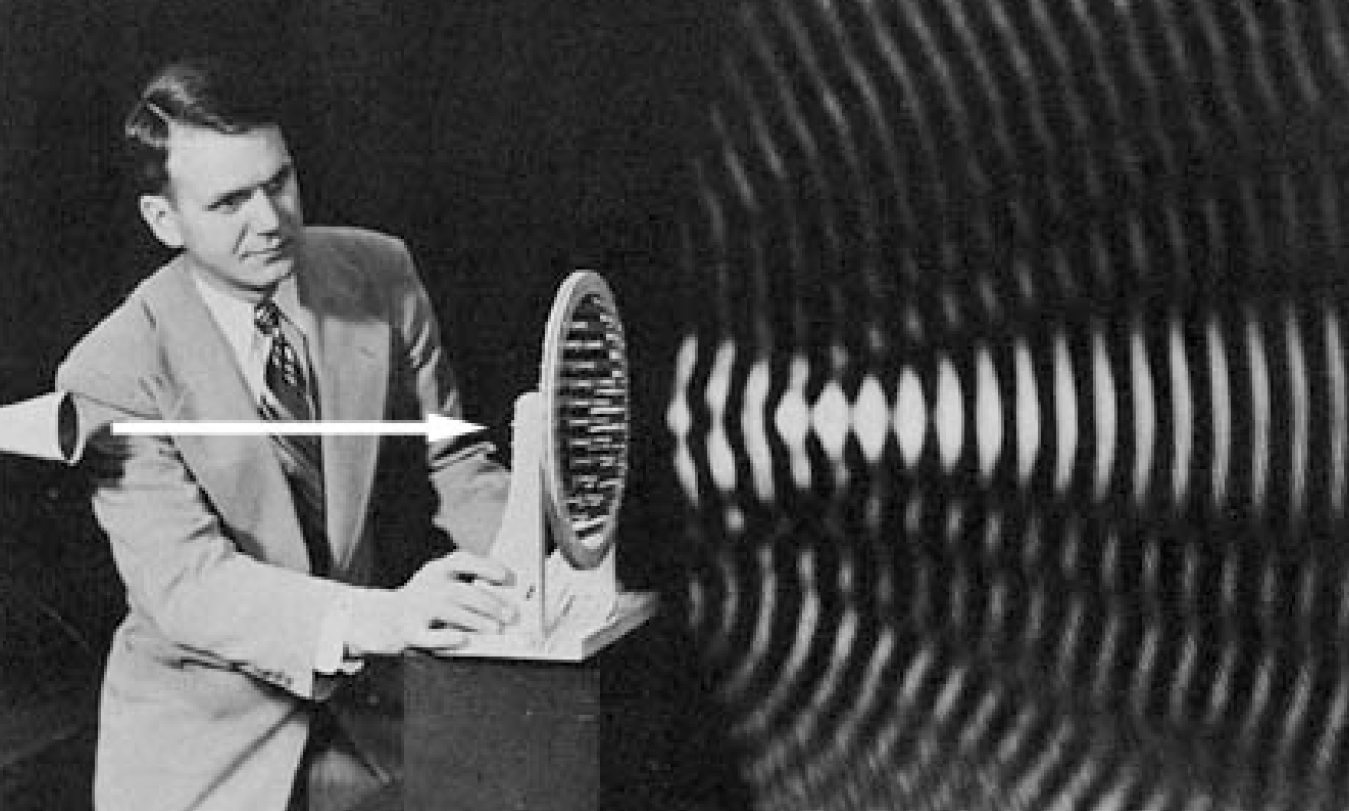
Despite the very real results, this topic is often the reason for informational speculations, fakes and other unpleasant things (see “brown note”, “frequency of death”, etc.). This post will be devoted only to real-life projects and advanced research on weapons of this type, I will not touch upon myths and fakes.
A little later, in the cycle “Lieutenant Schmidt’s Audiobub,” there will be a separate post with a review of the most popular sound weapon tales.
')
It is difficult to say exactly when the history of using sound as a weapon begins. War drums are known among many nations, and with the advent of firearms until the end of the 19th century, the loud sound of a shot was considered its dignity.
If we talk about the first known attempts to create a specific sound weapon, we should mention the German scientist, Dr. Richard Vallaushek and his acoustic gun, which was tested in the Austrian Tyrol in 1944 (a separate material will be devoted to the history of this device). Wallaushek’s gun was not brought to mass production, but his ideas were continued in the USA, where so-called sound projectors.
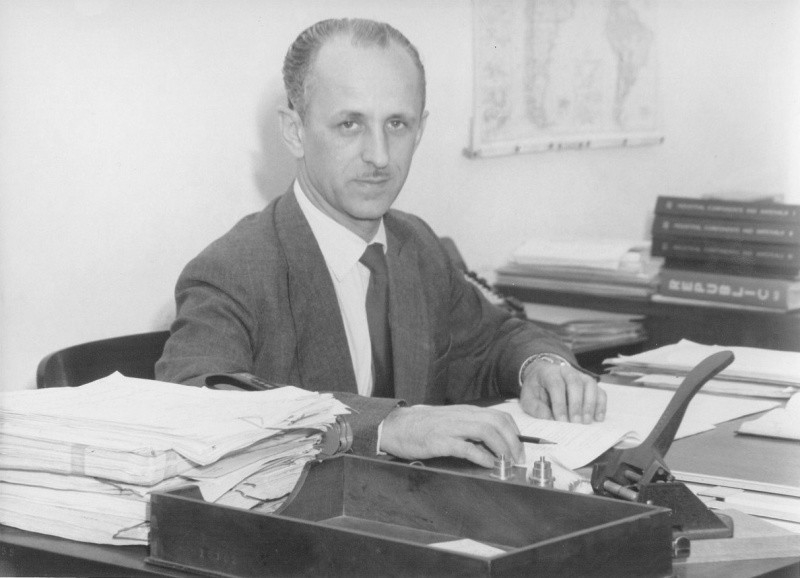
Richard Vallaushek
The most successful, mass-produced and often mentioned in the media weapons of this type is the LRAD (Long Range Acoustic Device) - a narrowly focused, powerful acoustic emitter developed by American Technology Corporation in the year 2000. The device was developed by a team of engineers under the leadership of the designer of non-lethal weapons, the famous inventor and head of the company Vuddi Norris (Elwood Norris).

Woodie norris
Initially, the device was positioned as a means of dispersing demonstrations. In the future, its functionality was expanded and recognized as effective as a defense against the attack of terrorists, pirates, auxiliary means when conducting combat in urban areas and as a means of suppressing an aggressive crowd.
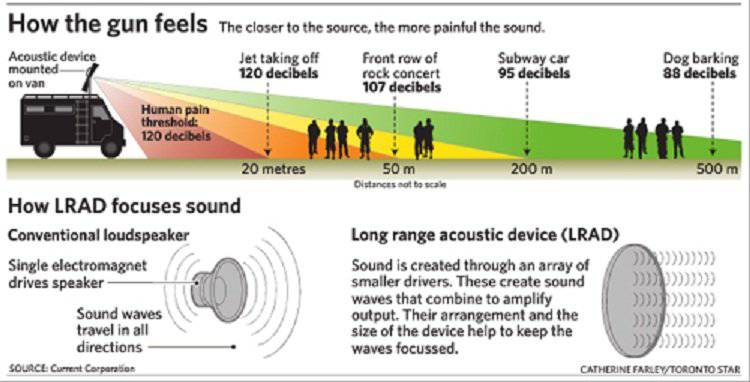
In weapons, as the name implies, a target is struck with sound force. So the working sound pressure (SPL) of various LRAD models at a distance of a lesion is from 136 to 162 dB. As a comparison, the SPL noise from the operating engines of the passenger liner, which is 120 dB, is often given, the pressure when using the Wall of Sound of the Grateful Dead is 110 dB, the SPL at which the eardrums are damaged is 130 dB.
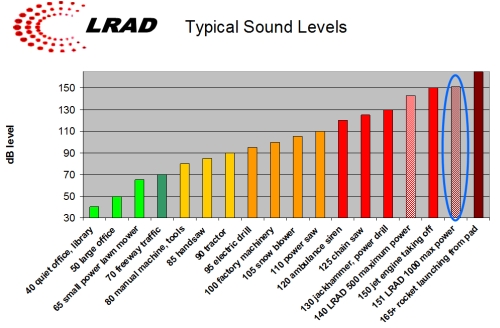
The operating frequency range that was chosen for the hitting sound signal is from 2.1 to 3.1 kHz. The frequency most frequently used is 2.5 kHz, while the loudspeaker is capable of creating a sound beam from 30-60 °, which allows the system to be used selectively. LRAD can also be used as banal loudspeakers, which are used for alerts from the cycle: “Young people, go away! Stop smashing dry closets and no one will suffer! ”.
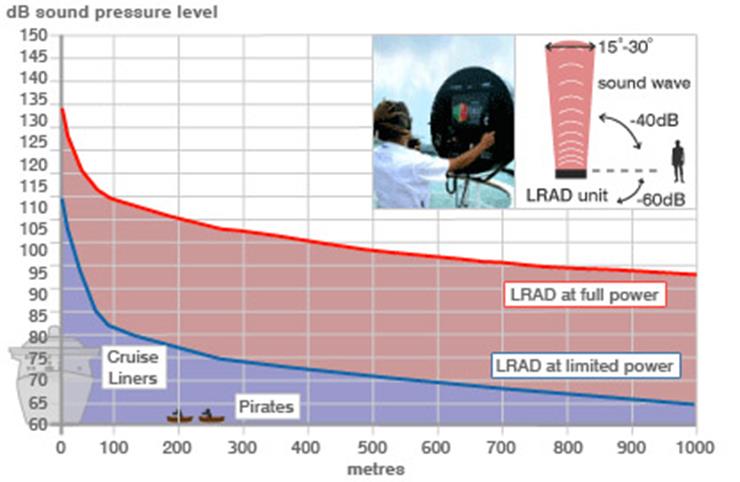
LRAD has both psychological and somatic damaging effects. Damage to the device can cause: a sense of fear, psycho-emotional destabilization of the target, severe pain in the ears, almost guaranteed damage to the eardrum, disorientation, dizziness, nausea, and even vomiting. People with a labile psyche may develop panic attacks.

Several variants of LRAD were developed with different mass-dimensional characteristics, power and range of destruction. Humane opponents of weapons claim that powerful LRAD modifications can damage internal organs. They also claim that the effects of LRAD can be lethal.
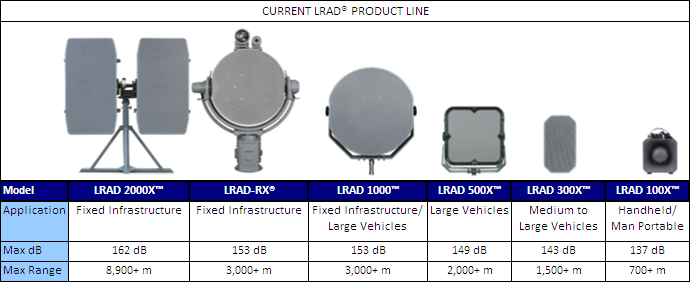
Such conclusions are made on the basis of studies in which experiments were conducted on animals. But the fact is that in these studies, the internal organs effectively influenced the waves outside the audible spectrum. For example, high-intensity ultrasound (in the range from 700 kHz to 3.6 MHz) caused damage to the intestines and lungs in mice. It is also known that after vibroacoustic stimulation in animals arrhythmias, atrial flutter and bradycardia occurred.
During its existence, LRAD was repeatedly used in police and military (Iraq, Afghanistan, Syria) operations, the most well-known users are the US Army and Police, the FBI, the US private military companies, the Singapore Navy, the Georgian Police, the Coast Guard of Japan, The Navy of Senegal, Togo and Côte d'Ivoire, and others. A total of 24 states and about 100 private companies, usually marine.
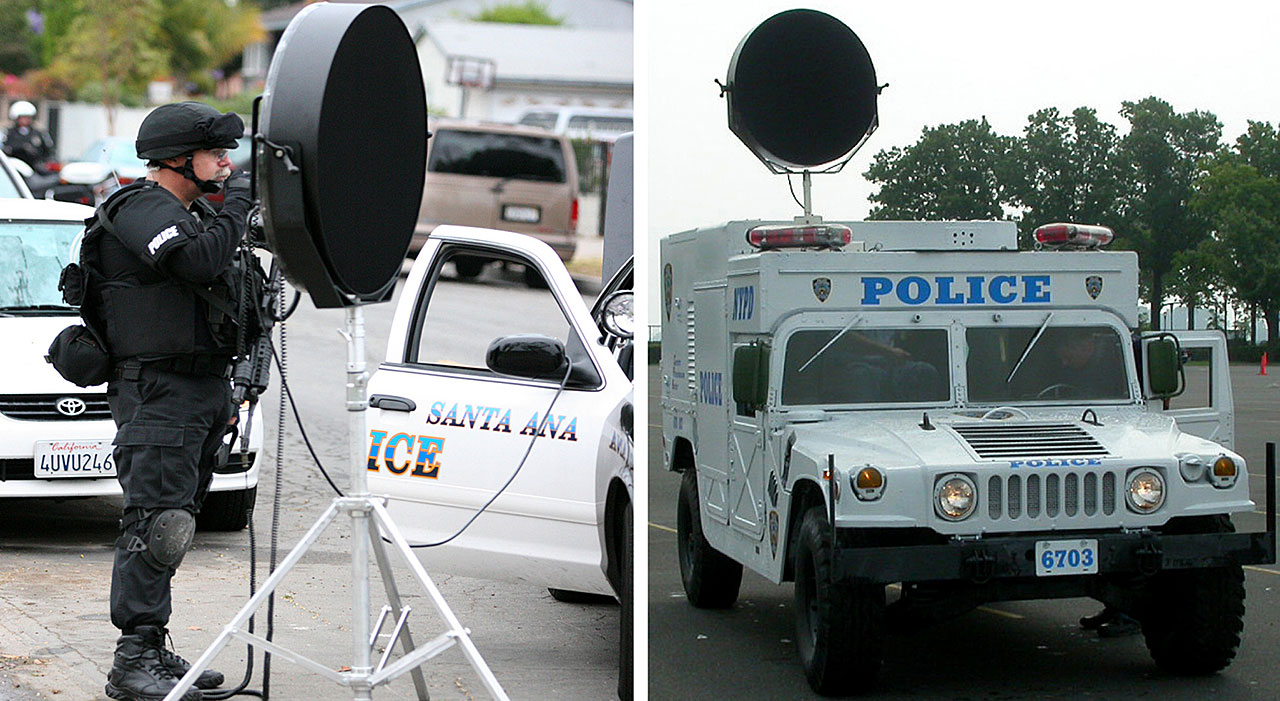
One of the most famous cases of successful use of LRAD is the reflection of the attack of Somali pirates on the Seabourn Spirit cruise liner in 2005. When LRAD turned the attackers to flight. The cost of the device on board was $ 30,000.

Also known is the incident with tanker MV Biscaglia in 2008, equipped with LRAD, which was captured by pirates. According to some data, the team did not have time to use the emitters in battle against pirates armed with RPG-7 and AK-74, according to others - the pirates used headphones as a means of individual protection. In 2007, the LRAD was used by the Georgian police against demonstrators in Tbilisi.
To create an acoustic weapon, they are trying to actively apply the microwave acoustic effect (Microwave Auditory Effect). This effect lies in the fact that under the influence of microwave radiation inside our skull sounds and we hear them without any devices. For the first time this effect was noticed by the staff of the radar stations during the Second World War. They complained about the appearance of extraneous noise near powerful microwave emitters.
In 1961, the effect was described by American neurophysiologist Allan Frey. He published a detailed article about the phenomenon in the Journal of Applied Physiology, in which he proved that under the influence of pulsed and modulated microwave radiation in the tissues around the cochlea it is absorbed. At the same time, the tissues heat up and expand under the influence of heat. This process in turn leads to the appearance of pressure waves, i.e. sound. Considering that the process occurs intracranially, the surroundings do not hear any sounds.
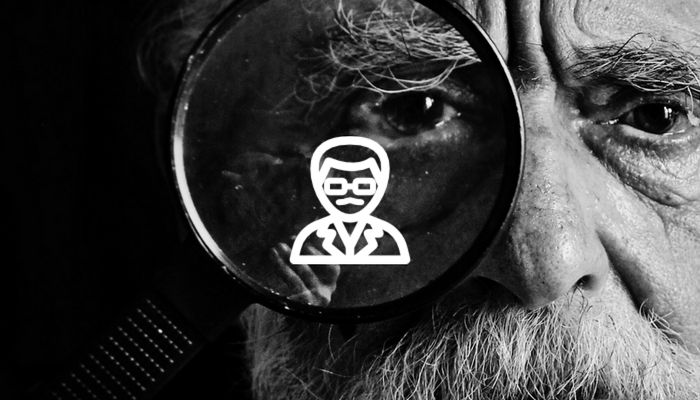
Alan H. Frey
Frey used a repetition rate of 50 Hz and a pulse duration of 10 to 70 microseconds. Frey discovered that the volume perceived by the target was related to the peak power density, and not to the average, as previously thought. At a frequency of 1.245 GHz, the peak power density for perception was below 80 mW / cm sq. Frey also noted that the transmitted signal can be perceived as noise of a different nature, as well as a feeling of pins and needles in the head.
Since the 1970s, work was carried out in the United States to create equipment that would allow the intentional shaping of sounds inside the head. Initially, it was supposed to use such a device for peaceful purposes, such as a hearing aid and a means of communication, but the detrimental effect of microwave radiation limited the interests of developers to the creation of non-lethal weapons. In 1989, US patent No. 4,877,027 appeared, which describes a device capable of transmitting sound through microwaves.
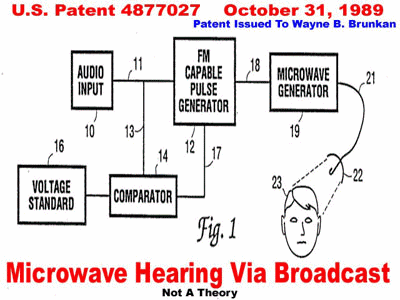
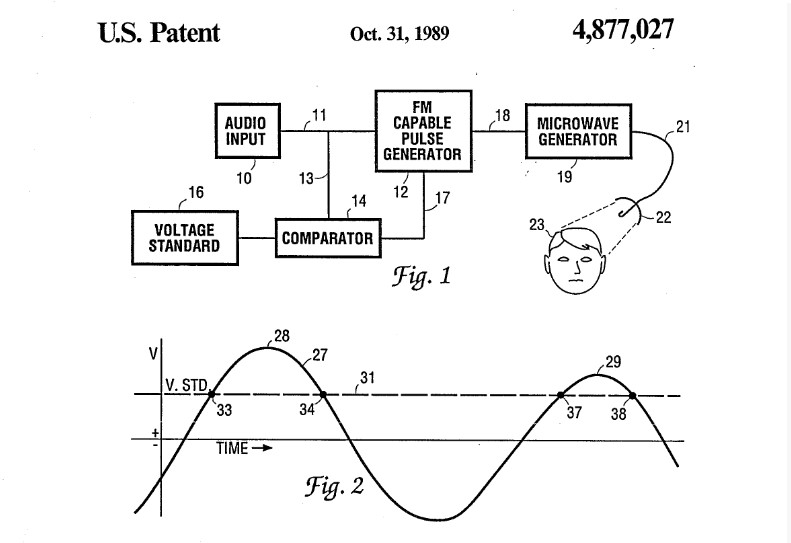
In 1991, the Russian Institute of Theoretical and Experimental Biophysics of the Russian Academy of Sciences publishes a brochure entitled “The Physical Foundations of the Microwave Hearing Effect”, where it is written in Russian that as a result of experiments it is established that a pulsed microwave field excites acoustic oscillations in the tissues around the cochlea . The pamphlet is based on the work of V. V. Shorokhov “The Mechanism of the Hearing Effect of Pulsed Microwave Field Fields” 1988 and the research of R. E. Tigranyan. Like Frey in the 60s, Soviet scientists noted that, depending on the parameters of the transmitter, the subjects hear hissing, humming, clicking, knocking, and may also experience foreign sensations in their heads and discomfort.

In the course of research conducted in the United States and the USSR, it was proved that when the modulating signal changes, it is possible to transmit information in the form of separate words, phrases and sounds. Depending on the parameters of the modulating signal, the sound transmitted through the microwave waves can be annoying, cause nausea and vomiting, and also lead to loss of consciousness and the ability to resist.
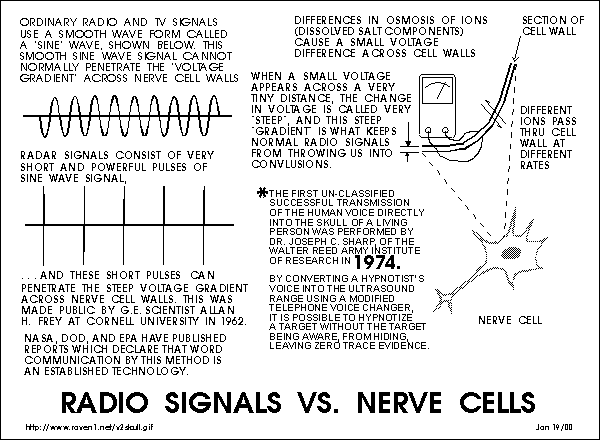
In 1974, Kenneth Foster from the University of Pennsylvania successfully conducted an experiment in transmitting a speech-modulated signal. In his study, he noted that a hypothetically dangerous density of energy flow is necessary for such a transfer. A 1975 article is also known, in which neuropsychologist Don Justesen talks about the effect of radiation on a person’s perception. In this article, reference is made to the experiment of Joseph Sharp and Mark Grove at the Arthur Research Institute. Walter Reed, who also went through 1974
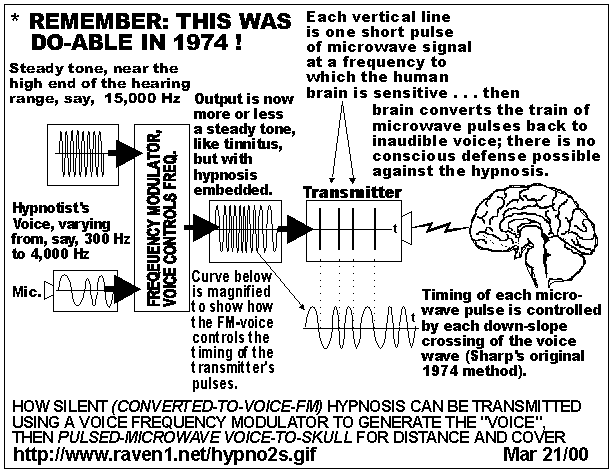
In the course of the study, Sharpe and Grove report that nine of the ten words that were transmitted using the microwaves modulated by the voice-modulated microwaves. Radiation levels at this transmission were close to 10 mW / cm², which is a safe exposure threshold. With a lower density, the recognition of speech information decreased. Many researchers note that under such conditions damage to the brain from the thermal effects of microwave radiation is possible.
In 2004, an experimental combat system, Mob Excess Deterrent Using Silent Audio or MEDUSA, was created based on the effect of WaveBand Corporation. "Mobile superior deterrence using silent audio."
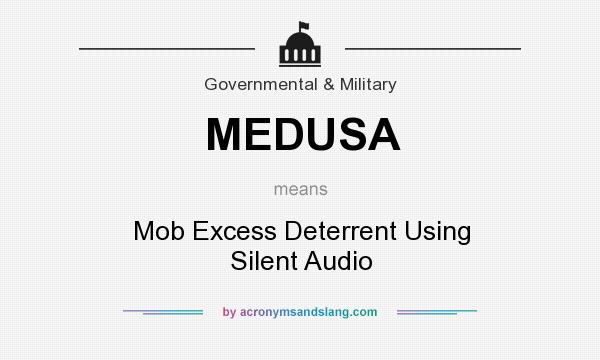
The developers have achieved the ability to cause the device with a feeling of strong discomfort, as well as the “turning off” (“disabling”) of individuals or groups. In 2005, Sierra Nevada bought WaveBand Corporation and closed the MEDUSA development theme for 3 years. In 2008, a number of media outlets published information that Sierra Nevada is engaged in the further development of the topic.
According to the description of the developers, as a result of exposure to MEDUSA in the head of the target, an invisible to the surrounding beam of microwave radiation creates a loud sound, reminiscent of a scream that lasts while the person is in the zone of influence of the device. The sound can not be stopped by closing the ears. The device was not serially released, there is no data on the delivery of prototypes in open sources.

Ken Foster, professor of bioengineering at the University of Pennsylvania
Kenneth Foster (see above) and Bill Guyznizili, a professor at the University of Washington, strongly criticized the effectiveness of the proposed device and expressed doubts about its non-lethality. Foster noted that due to the peculiarities of human biophysics, the device: “will kill you before the noise bothers you”. Guysnisili confirmed Foster's assessment and said that: "there will be no danger from sound compared to that which will come from heat."
There is an opinion that these assessments buried the project, but did not officially stop it and did not close it. Just stopped PR in the media. There are also judgments that the criticism was planned, and the project decided to continue “quietly”.
The influence of infrasound is associated most of all myths, but this does not mean that it cannot be used as a weapon. The effects of low-frequency waves are mainly psychological. Infrasound is associated with increased emotion and the formation of a feeling of fear.
The question of the effect of infrasound on the psyche is not worth it - it affects, but in different studies the effects of its use are described differently. So some researchers argue that infrasonic vibrations cause "horror, panic and confusion," others that "reinforce the existing emotional background."
It is also known that, according to NASA studies, oscillations with a frequency of 19 Hz, the source of which are rocket engines, affect the eyeballs and can cause visual disturbances in astronauts, including the formation of various kinds of vision.
There is also the opinion that infrasound (as well as ultrasound) is capable of damaging the internal organs of a person by resonant frequencies. This hypothesis has been partially disproved by scientists of the American Institute of Ultrasound in Medicine (AIUM).
Their research has shown that no proven biological effects were observed associated with an unfocused sound beam with an intensity below 100 mW / cm² SPTA or focused sound beams below an intensity level of 1 W / cm² SPTA. This applies to both infrasound with ultrasound and the audible spectrum.
On the effects of infrasound based on modern Russian non-lethal weapons, called "Whisper". The device is a shield of a law enforcement officer, with an infrasonic oscillation emitter built into it.
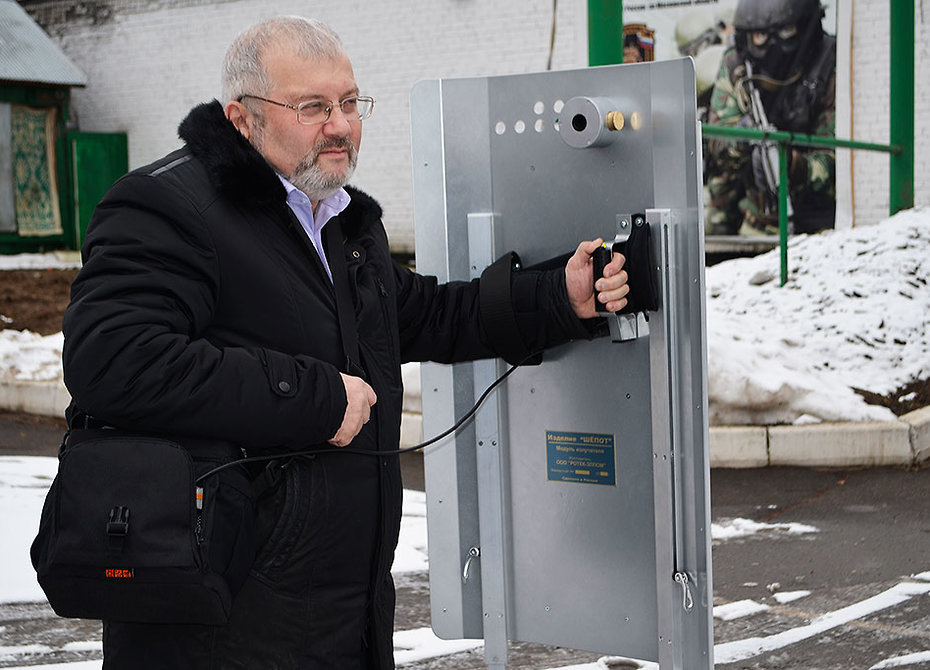
The device was developed in 2014 and in 2015 entered service in the Ministry of Internal Affairs, having been previously tested in the FPS. In 2016, there were reports that the device will also use the Rosguard. It is known that the first 5 shields cost the Ministry of Internal Affairs 7.5 million rubles, as reported by Tehnoomsk .
Also, the cost of the special equipment was illuminated in LiveJournal, where the amount of 1,513,384 rubles 57 kopecks per set was mentioned . In 2016, the Ministry of Internal Affairs of Russia announced a competition for a similar mobile system of greater power placed on the trailer, as reported by @marks . The initial contract price was 5.1 million rubles. It is also known that this year they planned to spend 62 million rubles on the purchase of “Shepot” for the Russian Guard.
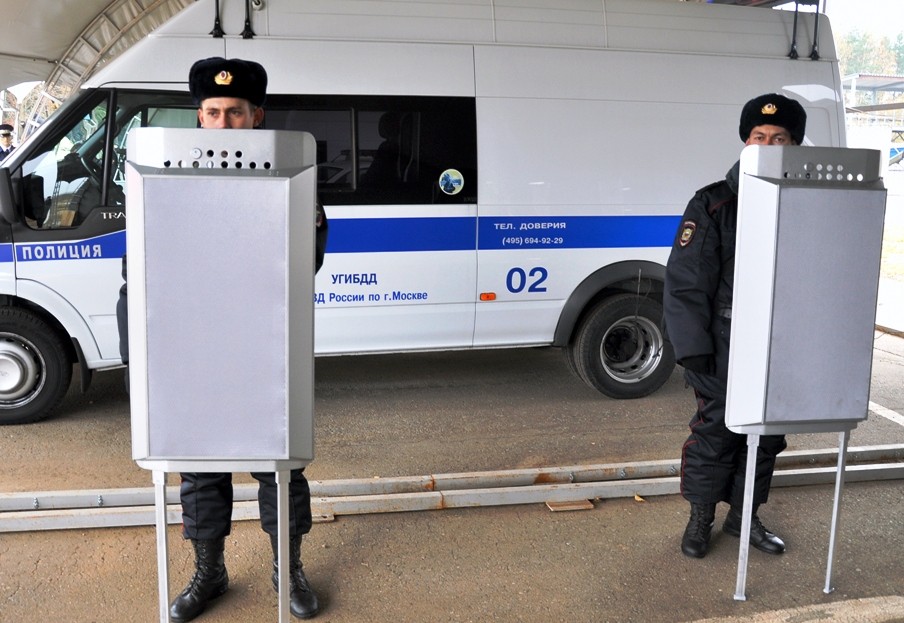
Where was the development of the device is unknown, but even in 2015 some of its performance characteristics were published. So it is known that “Whisper” generates sound vibrations from two emitters, which form a non-linear-parametric region of infrasonic influence. The oscillation frequency in the performance characteristics is not mentioned, but it is known that this is infrasound. The average value of acoustic pressure that “Whisper” is capable of creating at a distance of 10 m is 120 dB, the device’s battery life reaches 50 minutes, the time of continuous radiation is 30 seconds, and the interval between exposure periods is 15 seconds. There is no data on the combat and experimental use of the device in open sources.
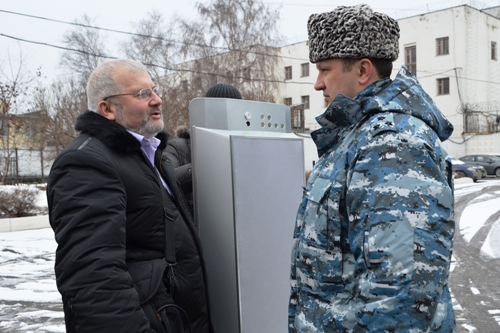
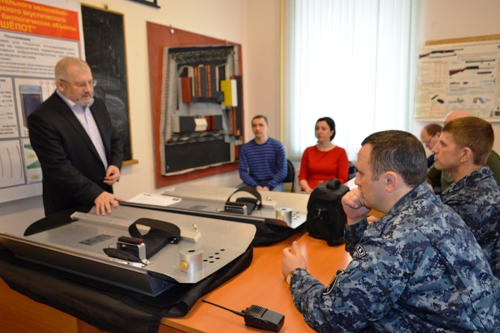
Unlike common myths, a sonic weapon does not explode heads, is not tuned to the “frequency of death” and is not capable of causing an involuntary act of defecation. At the same time, research conducted in this area has apparently led to tangible results. Some existing samples are already being mass-produced and massively used by the police and military. I described the most noticeable, in my opinion, developments in this area. I will return to this topic, since it is quite difficult to put all the interesting things into one material. I would appreciate your opinions in the comments.
Photocontent and materials were used for preparation:
patents.google.com/patent/US4877027A/en
boeing-is-back.livejournal.com
twower.livejournal.com
defendingrussia.ru
howgreenisthis.org
www.ted.com
slavaland.ru
www.2eguerremondiale.fr
xakac.info
topwar.ru
patents.google.com/patent/US4877027A/en
defpost.com
militaryreview.su
skewsme.com
slowdigital.com
lancasteronline.com
news.bbc.co.uk
Jeans
There is no special equipment and sound weapons in our catalog , but there are UMZCH, acoustic systems, DAC, headphones and other high fidelity audio equipment.

Despite the very real results, this topic is often the reason for informational speculations, fakes and other unpleasant things (see “brown note”, “frequency of death”, etc.). This post will be devoted only to real-life projects and advanced research on weapons of this type, I will not touch upon myths and fakes.
A little later, in the cycle “Lieutenant Schmidt’s Audiobub,” there will be a separate post with a review of the most popular sound weapon tales.
')
Sound guns
It is difficult to say exactly when the history of using sound as a weapon begins. War drums are known among many nations, and with the advent of firearms until the end of the 19th century, the loud sound of a shot was considered its dignity.
If we talk about the first known attempts to create a specific sound weapon, we should mention the German scientist, Dr. Richard Vallaushek and his acoustic gun, which was tested in the Austrian Tyrol in 1944 (a separate material will be devoted to the history of this device). Wallaushek’s gun was not brought to mass production, but his ideas were continued in the USA, where so-called sound projectors.

Richard Vallaushek
The most successful, mass-produced and often mentioned in the media weapons of this type is the LRAD (Long Range Acoustic Device) - a narrowly focused, powerful acoustic emitter developed by American Technology Corporation in the year 2000. The device was developed by a team of engineers under the leadership of the designer of non-lethal weapons, the famous inventor and head of the company Vuddi Norris (Elwood Norris).

Woodie norris
Initially, the device was positioned as a means of dispersing demonstrations. In the future, its functionality was expanded and recognized as effective as a defense against the attack of terrorists, pirates, auxiliary means when conducting combat in urban areas and as a means of suppressing an aggressive crowd.

In weapons, as the name implies, a target is struck with sound force. So the working sound pressure (SPL) of various LRAD models at a distance of a lesion is from 136 to 162 dB. As a comparison, the SPL noise from the operating engines of the passenger liner, which is 120 dB, is often given, the pressure when using the Wall of Sound of the Grateful Dead is 110 dB, the SPL at which the eardrums are damaged is 130 dB.

The operating frequency range that was chosen for the hitting sound signal is from 2.1 to 3.1 kHz. The frequency most frequently used is 2.5 kHz, while the loudspeaker is capable of creating a sound beam from 30-60 °, which allows the system to be used selectively. LRAD can also be used as banal loudspeakers, which are used for alerts from the cycle: “Young people, go away! Stop smashing dry closets and no one will suffer! ”.

LRAD has both psychological and somatic damaging effects. Damage to the device can cause: a sense of fear, psycho-emotional destabilization of the target, severe pain in the ears, almost guaranteed damage to the eardrum, disorientation, dizziness, nausea, and even vomiting. People with a labile psyche may develop panic attacks.

Several variants of LRAD were developed with different mass-dimensional characteristics, power and range of destruction. Humane opponents of weapons claim that powerful LRAD modifications can damage internal organs. They also claim that the effects of LRAD can be lethal.

Such conclusions are made on the basis of studies in which experiments were conducted on animals. But the fact is that in these studies, the internal organs effectively influenced the waves outside the audible spectrum. For example, high-intensity ultrasound (in the range from 700 kHz to 3.6 MHz) caused damage to the intestines and lungs in mice. It is also known that after vibroacoustic stimulation in animals arrhythmias, atrial flutter and bradycardia occurred.
During its existence, LRAD was repeatedly used in police and military (Iraq, Afghanistan, Syria) operations, the most well-known users are the US Army and Police, the FBI, the US private military companies, the Singapore Navy, the Georgian Police, the Coast Guard of Japan, The Navy of Senegal, Togo and Côte d'Ivoire, and others. A total of 24 states and about 100 private companies, usually marine.

One of the most famous cases of successful use of LRAD is the reflection of the attack of Somali pirates on the Seabourn Spirit cruise liner in 2005. When LRAD turned the attackers to flight. The cost of the device on board was $ 30,000.

Also known is the incident with tanker MV Biscaglia in 2008, equipped with LRAD, which was captured by pirates. According to some data, the team did not have time to use the emitters in battle against pirates armed with RPG-7 and AK-74, according to others - the pirates used headphones as a means of individual protection. In 2007, the LRAD was used by the Georgian police against demonstrators in Tbilisi.
Silent screaming jellyfish and hotheads hear better
To create an acoustic weapon, they are trying to actively apply the microwave acoustic effect (Microwave Auditory Effect). This effect lies in the fact that under the influence of microwave radiation inside our skull sounds and we hear them without any devices. For the first time this effect was noticed by the staff of the radar stations during the Second World War. They complained about the appearance of extraneous noise near powerful microwave emitters.
In 1961, the effect was described by American neurophysiologist Allan Frey. He published a detailed article about the phenomenon in the Journal of Applied Physiology, in which he proved that under the influence of pulsed and modulated microwave radiation in the tissues around the cochlea it is absorbed. At the same time, the tissues heat up and expand under the influence of heat. This process in turn leads to the appearance of pressure waves, i.e. sound. Considering that the process occurs intracranially, the surroundings do not hear any sounds.

Alan H. Frey
Frey used a repetition rate of 50 Hz and a pulse duration of 10 to 70 microseconds. Frey discovered that the volume perceived by the target was related to the peak power density, and not to the average, as previously thought. At a frequency of 1.245 GHz, the peak power density for perception was below 80 mW / cm sq. Frey also noted that the transmitted signal can be perceived as noise of a different nature, as well as a feeling of pins and needles in the head.
Since the 1970s, work was carried out in the United States to create equipment that would allow the intentional shaping of sounds inside the head. Initially, it was supposed to use such a device for peaceful purposes, such as a hearing aid and a means of communication, but the detrimental effect of microwave radiation limited the interests of developers to the creation of non-lethal weapons. In 1989, US patent No. 4,877,027 appeared, which describes a device capable of transmitting sound through microwaves.


In 1991, the Russian Institute of Theoretical and Experimental Biophysics of the Russian Academy of Sciences publishes a brochure entitled “The Physical Foundations of the Microwave Hearing Effect”, where it is written in Russian that as a result of experiments it is established that a pulsed microwave field excites acoustic oscillations in the tissues around the cochlea . The pamphlet is based on the work of V. V. Shorokhov “The Mechanism of the Hearing Effect of Pulsed Microwave Field Fields” 1988 and the research of R. E. Tigranyan. Like Frey in the 60s, Soviet scientists noted that, depending on the parameters of the transmitter, the subjects hear hissing, humming, clicking, knocking, and may also experience foreign sensations in their heads and discomfort.

In the course of research conducted in the United States and the USSR, it was proved that when the modulating signal changes, it is possible to transmit information in the form of separate words, phrases and sounds. Depending on the parameters of the modulating signal, the sound transmitted through the microwave waves can be annoying, cause nausea and vomiting, and also lead to loss of consciousness and the ability to resist.

In 1974, Kenneth Foster from the University of Pennsylvania successfully conducted an experiment in transmitting a speech-modulated signal. In his study, he noted that a hypothetically dangerous density of energy flow is necessary for such a transfer. A 1975 article is also known, in which neuropsychologist Don Justesen talks about the effect of radiation on a person’s perception. In this article, reference is made to the experiment of Joseph Sharp and Mark Grove at the Arthur Research Institute. Walter Reed, who also went through 1974

In the course of the study, Sharpe and Grove report that nine of the ten words that were transmitted using the microwaves modulated by the voice-modulated microwaves. Radiation levels at this transmission were close to 10 mW / cm², which is a safe exposure threshold. With a lower density, the recognition of speech information decreased. Many researchers note that under such conditions damage to the brain from the thermal effects of microwave radiation is possible.
In 2004, an experimental combat system, Mob Excess Deterrent Using Silent Audio or MEDUSA, was created based on the effect of WaveBand Corporation. "Mobile superior deterrence using silent audio."

The developers have achieved the ability to cause the device with a feeling of strong discomfort, as well as the “turning off” (“disabling”) of individuals or groups. In 2005, Sierra Nevada bought WaveBand Corporation and closed the MEDUSA development theme for 3 years. In 2008, a number of media outlets published information that Sierra Nevada is engaged in the further development of the topic.
According to the description of the developers, as a result of exposure to MEDUSA in the head of the target, an invisible to the surrounding beam of microwave radiation creates a loud sound, reminiscent of a scream that lasts while the person is in the zone of influence of the device. The sound can not be stopped by closing the ears. The device was not serially released, there is no data on the delivery of prototypes in open sources.

Ken Foster, professor of bioengineering at the University of Pennsylvania
Kenneth Foster (see above) and Bill Guyznizili, a professor at the University of Washington, strongly criticized the effectiveness of the proposed device and expressed doubts about its non-lethality. Foster noted that due to the peculiarities of human biophysics, the device: “will kill you before the noise bothers you”. Guysnisili confirmed Foster's assessment and said that: "there will be no danger from sound compared to that which will come from heat."
There is an opinion that these assessments buried the project, but did not officially stop it and did not close it. Just stopped PR in the media. There are also judgments that the criticism was planned, and the project decided to continue “quietly”.
Infrasound and “Whisper” to disperse demonstrators
The influence of infrasound is associated most of all myths, but this does not mean that it cannot be used as a weapon. The effects of low-frequency waves are mainly psychological. Infrasound is associated with increased emotion and the formation of a feeling of fear.
The question of the effect of infrasound on the psyche is not worth it - it affects, but in different studies the effects of its use are described differently. So some researchers argue that infrasonic vibrations cause "horror, panic and confusion," others that "reinforce the existing emotional background."
It is also known that, according to NASA studies, oscillations with a frequency of 19 Hz, the source of which are rocket engines, affect the eyeballs and can cause visual disturbances in astronauts, including the formation of various kinds of vision.
There is also the opinion that infrasound (as well as ultrasound) is capable of damaging the internal organs of a person by resonant frequencies. This hypothesis has been partially disproved by scientists of the American Institute of Ultrasound in Medicine (AIUM).
Their research has shown that no proven biological effects were observed associated with an unfocused sound beam with an intensity below 100 mW / cm² SPTA or focused sound beams below an intensity level of 1 W / cm² SPTA. This applies to both infrasound with ultrasound and the audible spectrum.
On the effects of infrasound based on modern Russian non-lethal weapons, called "Whisper". The device is a shield of a law enforcement officer, with an infrasonic oscillation emitter built into it.

The device was developed in 2014 and in 2015 entered service in the Ministry of Internal Affairs, having been previously tested in the FPS. In 2016, there were reports that the device will also use the Rosguard. It is known that the first 5 shields cost the Ministry of Internal Affairs 7.5 million rubles, as reported by Tehnoomsk .
Also, the cost of the special equipment was illuminated in LiveJournal, where the amount of 1,513,384 rubles 57 kopecks per set was mentioned . In 2016, the Ministry of Internal Affairs of Russia announced a competition for a similar mobile system of greater power placed on the trailer, as reported by @marks . The initial contract price was 5.1 million rubles. It is also known that this year they planned to spend 62 million rubles on the purchase of “Shepot” for the Russian Guard.

Where was the development of the device is unknown, but even in 2015 some of its performance characteristics were published. So it is known that “Whisper” generates sound vibrations from two emitters, which form a non-linear-parametric region of infrasonic influence. The oscillation frequency in the performance characteristics is not mentioned, but it is known that this is infrasound. The average value of acoustic pressure that “Whisper” is capable of creating at a distance of 10 m is 120 dB, the device’s battery life reaches 50 minutes, the time of continuous radiation is 30 seconds, and the interval between exposure periods is 15 seconds. There is no data on the combat and experimental use of the device in open sources.


Total
Unlike common myths, a sonic weapon does not explode heads, is not tuned to the “frequency of death” and is not capable of causing an involuntary act of defecation. At the same time, research conducted in this area has apparently led to tangible results. Some existing samples are already being mass-produced and massively used by the police and military. I described the most noticeable, in my opinion, developments in this area. I will return to this topic, since it is quite difficult to put all the interesting things into one material. I would appreciate your opinions in the comments.
Photocontent and materials were used for preparation:
patents.google.com/patent/US4877027A/en
boeing-is-back.livejournal.com
twower.livejournal.com
defendingrussia.ru
howgreenisthis.org
www.ted.com
slavaland.ru
www.2eguerremondiale.fr
xakac.info
topwar.ru
patents.google.com/patent/US4877027A/en
defpost.com
militaryreview.su
skewsme.com
slowdigital.com
lancasteronline.com
news.bbc.co.uk
Jeans
There is no special equipment and sound weapons in our catalog , but there are UMZCH, acoustic systems, DAC, headphones and other high fidelity audio equipment.
Source: https://habr.com/ru/post/422095/
All Articles